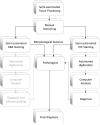Computer-aided detection of prostate cancer on tissue sections
- PMID: 19417626
- PMCID: PMC2836393
- DOI: 10.1097/PAI.0b013e31819e6d65
Computer-aided detection of prostate cancer on tissue sections
Abstract
We report an automated computer technique for detection of prostate cancer in prostate tissue sections processed with immunohistochemistry. Two sets of color optical images were acquired from prostate tissue sections stained with a double-chromogen triple-antibody cocktail combining alpha-methylacyl-CoA racemase, p63, and high-molecular-weight cytokeratin. The first set of images consisted of 20 training images (10 malignant) used for developing the computer technique and 15 test images (7 malignant) used for testing and optimizing the technique. The second set of images consisted of 299 images (114 malignant) used for evaluation of the performance of the computer technique. The computer technique identified image segments of alpha-methylacyl-CoA racemase-labeled malignant epithelial cells (red), p63, and high-molecular-weight cytokeratin-labeled benign basal cells (brown), and secretory and stromal cells (blue) for identifying prostate cancer automatically. The sensitivity and specificity of the computer technique were 94% (16/17) and 94% (17/18), respectively, on the first (training and test) set of images, and 88% (79/90) and 97% (136/140), respectively, on the second (validation) set of images. If high-grade prostatic intraepithelial neoplasia, which is a precursor of cancer, and atypical cases were included, the sensitivity and specificity were 85% (97/114) and 89% (165/185), respectively. These results show that the novel automated computer technique can accurately identify prostatic adenocarcinoma in the triple-antibody cocktail-stained prostate sections.
Figures








Similar articles
-
Anti-glutamate receptor 2 as a new potential diagnostic probe for prostatic adenocarcinoma: a pilot immunohistochemical study.Appl Immunohistochem Mol Morphol. 2012 Jul;20(4):344-9. doi: 10.1097/PAI.0b013e31824013ba. Appl Immunohistochem Mol Morphol. 2012. PMID: 22417861 Free PMC article.
-
Diagnostic utility of a p63/alpha-methyl-CoA-racemase (p504s) cocktail in atypical foci in the prostate.Mod Pathol. 2004 Oct;17(10):1180-90. doi: 10.1038/modpathol.3800197. Mod Pathol. 2004. PMID: 15205683
-
Alpha-methylacyl-CoA racemase (P504S)/34betaE12/p63 triple cocktail stain in prostatic adenocarcinoma after hormonal therapy.Hum Pathol. 2007 Feb;38(2):332-41. doi: 10.1016/j.humpath.2006.08.016. Epub 2006 Nov 28. Hum Pathol. 2007. PMID: 17134736
-
Application of alpha-methylacyl coenzyme A racemase immunohistochemistry in the diagnosis of prostate cancer: a review.Anal Quant Cytol Histol. 2006 Feb;28(1):1-13. Anal Quant Cytol Histol. 2006. PMID: 16566275 Review.
-
Best practice in diagnostic immunohistochemistry: prostate carcinoma and its mimics in needle core biopsies.Arch Pathol Lab Med. 2008 Sep;132(9):1388-96. doi: 10.5858/2008-132-1388-BPIDIP. Arch Pathol Lab Med. 2008. PMID: 18788849 Review.
Cited by
-
An Efficient Computational Framework for the Analysis of Whole Slide Images: Application to Follicular Lymphoma Immunohistochemistry.J Comput Sci. 2012 Sep 1;3(5):269-279. doi: 10.1016/j.jocs.2012.01.009. Epub 2012 Mar 6. J Comput Sci. 2012. PMID: 22962572 Free PMC article.
-
New morphological features for grading pancreatic ductal adenocarcinomas.Biomed Res Int. 2013;2013:175271. doi: 10.1155/2013/175271. Epub 2013 Jul 25. Biomed Res Int. 2013. PMID: 23984321 Free PMC article.
-
Systems pathology: a critical review.Mol Oncol. 2012 Feb;6(1):27-32. doi: 10.1016/j.molonc.2011.11.007. Epub 2011 Nov 27. Mol Oncol. 2012. PMID: 22178234 Free PMC article. Review.
-
IV Administered Gadodiamide Enters the Lumen of the Prostatic Glands: X-Ray Fluorescence Microscopy Examination of a Mouse Model.AJR Am J Roentgenol. 2015 Sep;205(3):W313-9. doi: 10.2214/AJR.14.14055. AJR Am J Roentgenol. 2015. PMID: 26295667 Free PMC article.
References
-
- Jemal A, Siegel R, Ward E, et al. Cancer statistics, 2008. CA Cancer J Clin. 2008;58:71–96. - PubMed
-
- Epstein JI, Yang XJ. Prostate biopsy interpretation. 3rd ed. Lippincott Williams & Wilkins; Philadelphia: 2002.
-
- Bostwick DG. Pathology of the Prostate. Churchill Livingstone; New York: 1990.
-
- Wojno KJ, Epstein JI. The utility of basal cell-specific anti-cytokeratin antibody (34-beta-E12) in the diagnosis of prostate-cancer—a review of 228 cases. Am J Surg Pathol. 1995;19:251–260. - PubMed
-
- Jiang Z, Woda BA, Rock KL, et al. P504S: a new molecular marker for the detection of prostate carcinoma. Am J Surg Patho. 2001;25:1397–1440. - PubMed
Publication types
MeSH terms
Grants and funding
LinkOut - more resources
Full Text Sources
Medical

